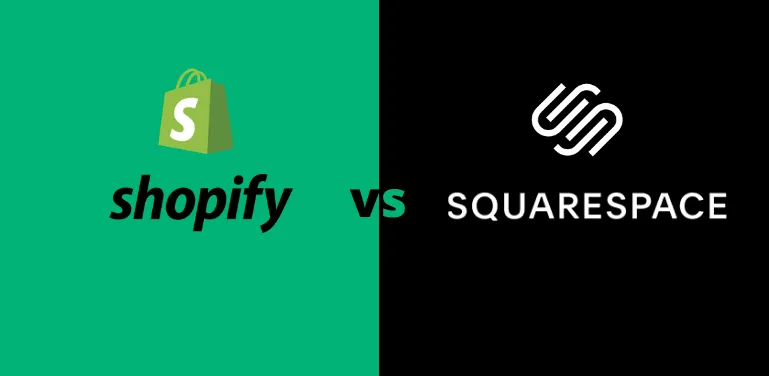It is predicted that by 2024, global e-commerce sales will exceed $6 trillion, with over 2.6 billion people shopping online regularly. This presents a vast wealth of opportunities. With platforms like Shopify and Squarespace emerging, setting up and creating your own e-commerce store has never been easier. However, simply setting up an online store and waiting for ideal customers to find it is not enough. As a business owner, you need an aesthetically pleasing design, easy-to-navigate menus, optimized SEO, and a delightful shopping interface, along with excellent product selection to support your business.

Many platforms offer e-commerce options, most of which integrate into your website for a one-stop solution. Squarespace is a general website builder with e-commerce capabilities, while Shopify is a platform specifically designed to help customers sell online. Although both are reliable options, they each have their strengths and weaknesses. In this guide, we will compare Squarespace and Shopify in detail to help you choose the platform that suits your needs.
Squarespace vs. Shopify: An Overview
When comparing Squarespace and Shopify, the focus should first be on their areas of specialization and scalability. Squarespace is more focused on content presentation and design aesthetics, making it suitable for users who need beautiful page displays, such as bloggers, portfolio creators, photographers, and creatives. Its design tools and templates emphasize visual appeal. However, the plugins and integrations it offers are somewhat limited; while it has some e-commerce functions, it is generally better suited for small to medium-sized stores. In terms of payment options, Squarespace integrates with PayPal and Stripe, but the choices are relatively limited. Its SEO and marketing tools are quite basic, making it suitable for beginners or small businesses. User support is mainly through email and chat, which is decent, but the community is relatively small. The subscription fee structure is straightforward, making it suitable for users on a tight budget.

In contrast, Shopify focuses on e-commerce and later added website-building capabilities. It has optimized every detail for online sales, particularly suited for users who wish to build large online stores. Shopify boasts a vast app store and developer community, allowing store functionality to be extended through third-party apps and supporting significant business growth. It offers a wide range of payment gateways, supports various global payment methods, and includes Shopify Payments, which can waive some transaction fees. Its SEO, social media integration, and marketing automation tools are more comprehensive, helping store owners better promote and manage their online shops. The support system is robust, including 24/7 support, forums, and numerous online tutorials, with an active community and abundant resources. However, the fee structure is more complex, with monthly fees plus potential app fees, payment processing fees, etc., making it more suitable for businesses with growth expectations and a willingness to invest.

Squarespace and Shopify both offer features for launching, maintaining, and expanding an online store within a website. Both platforms allow users to create an ideal website based on personal needs, thanks to rich design options and features, without requiring any coding knowledge or programming experience. Making the right choice for your business will depend on the features you need and how you want to connect with your customers.
2024 Comparison
| Feature | Squarespace | Shopify |
|---|---|---|
| Plan Fees | Personal Plan: $25/month, Business Plan: $36/month, Basic Commerce Plan: $40/month, Advanced Commerce Plan: $72/month. Monthly subscription prices are slightly higher. | Basic Plan: $39/month, Shopify Plan: $109/month, Advanced Plan: $399/month. Shopify Plus Plan: $2,300/month. Higher monthly subscription prices. |
| Templates & Design | Offers a rich library of free templates suitable for various industries. Templates are visually appealing and user-friendly. | Provides 10 free templates and over 50 paid templates. Although the selection is smaller, they are powerful and suitable for e-commerce use. |
| SEO Tools | All pages support custom meta descriptions and URLs, with Google Analytics available for every plan. Supports SEOSpace SEO plugin. | Automatically generates page titles and meta descriptions, simplifying compliance with Google’s core web vitals. Supports a wider range of SEO integrations. |
| Customer Support | Provides 24/7 email, social media, and online chat support, but does not offer phone support. | Offers 24/7 email, online chat, and phone support, but does not support social media. |
| Backup & Storage | Offers unlimited storage but requires manual backup of website content. | Provides unlimited storage but requires manual backup of website content. |
| E-commerce Capabilities | E-commerce features are tiered; basic plan only includes fundamental features, with more comprehensive tools available through upgrades. | Each plan includes robust e-commerce tools, supporting automated workflows and multi-channel sales. |
| Extensions & Integrations | Offers limited extension options and integrations; supports custom code integrations with fewer platform integrations. | Has a vast app marketplace offering thousands of integrations for sales, marketing, fulfillment, store management, and accounting. Supports Zapier. |
Challenges and Drawbacks: Analyzing Squarespace vs. Shopify
Challenges of Squarespace and Shopify
While Squarespace and Shopify each have their clear advantages, it’s also important not to overlook the challenges they present in practical application. Understanding these shortcomings can help you make a more informed decision. Below are some of the major issues with both platforms:
Shopify's Shortcomings
- Speed Issues: Despite offering various optimization options, Shopify’s page load speed remains slow, negatively affecting SEO and making it difficult to meet Google’s speed standards.
- Declining Customer Support: Initially, Shopify’s customer support was quite good, but it now primarily relies on chatbots. This has led to a decline in service quality, even as monthly fees have increased.
- Coding Requirements: Although Shopify claims no coding is necessary, in reality, users often need to learn the specific Shopify Liquid language, which isn’t applicable in other CMS platforms.
- Issues with the Trusted Advisor System: Shopify’s "Trusted Advisors" system has problems, as users receive a lot of spam and can't be sure if these advisors are truly certified by Shopify.
- App Issues: Shopify’s app system is not fully developed, with many apps performing poorly, slowing down the store, and often requiring developers to fix issues.
Squarespace's Shortcomings
- Limited Customization: Although Squarespace offers a variety of beautiful templates, its customization options are somewhat limited. The drag-and-drop editor may not satisfy all specific design needs.
- Basic E-commerce Features: Squarespace’s e-commerce features are suitable for small stores, but for large e-commerce businesses, they might not be robust enough, especially when complex inventory management is required.
- Limited Third-Party Integrations: Compared to Shopify, Squarespace has a more limited market for third-party apps and plugins, which may make it difficult for users to find the specific tools or features they need.
- Limited SEO Control: The SEO tools provided by Squarespace are fairly basic. Advanced users may find that they lack sufficient control over URL structures, page speed optimization, and custom meta tags.
- Limited Export Functionality: If users decide to migrate from Squarespace to another platform, the options for exporting content are limited, and some content may not be easily transferable.
Conclusion
For small businesses, Squarespace is better suited for those who need a simple, easy-to-use website that emphasizes design. Shopify, on the other hand, is more suitable for businesses focused on e-commerce that require robust sales features and multi-channel expansion. If your primary concern is the appearance and user experience of your website, Squarespace may be the better choice. If your business is centered around e-commerce and you plan to expand your sales channels, then Shopify is undoubtedly the more ideal option.













